Seeing Things: October 2008 Archives
Steve Reich Evening (Choreography by Anne Teresa De Keersmaeker)
BAM Howard Gilman Opera House, Brooklyn, N.Y. / October 22-25, 2008
All told, Anne Teresa De Keersmaeker's "Steve Reich Evening" had the deep civility of work made for an audience expected to think as well as to look and to listen.
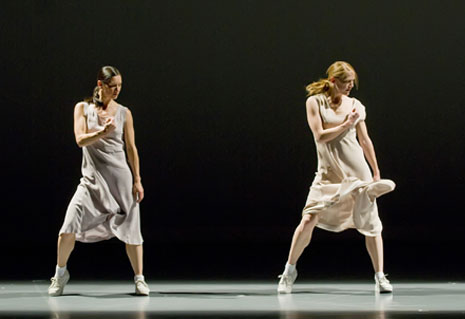
The full article appeared in Voice of Dance (http://www.voiceofdance.org) on October 24, 2008. To read it, click here.
This article originally appeared in the Culture section of Bloomberg News on October 14, 2008.
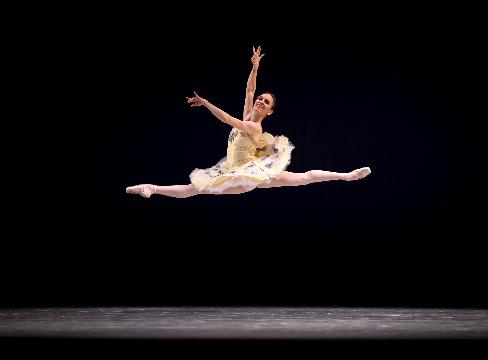
Tina LeBlanc takes part in the San Francisco Ballet's production of George Balanchine's "Divertimento No. 15" at New York City Center in New York on Oct. 10, 2008. Performances by the San Francisco Ballet will continue in New York through Oct. 18. Photographer: Erik Tomasson/San Francisco Ballet via Bloomberg News
Oct. 14 (Bloomberg) -- Five different couples, one giving way seamlessly to the next, share a sublime Mozart adagio and the effect is lovely -- but bland. San Francisco Ballet opened its nine-day engagement at New York City Center Friday evening with Balanchine's ``Divertimento No. 15,'' yet it wasn't quite the same dance the choreographer created in 1956 for his New York City Ballet. Like California's lifestyle compared to New York's, SFB's manner of moving is graciously relaxed and luxuriant rather than thrillingly razor-edged in its lines and avid in its attack.
In ``Divertimento No. 15,'' the Californian dancers aim to please, and please they do. Yet despite their commendable classical form, they ignore an essential hallmark of Balanchine, the shifts in timing and emphasis among steps and phrases. The atmosphere onstage remained that of a lawn party on a mild spring afternoon, the well-mannered figures in the landscape dutifully behaving as they had been taught.
Two dancers proved to be more animated. Gennadi Nedvigin, who combines modern-dance texture with a natural fluidity, and the seasoned ballerina Tina LeBlanc, who grew more and more intuitive in her musicality and ecstatic in her manner as the ballet unfolded.
Another Balanchine classic, ``The Four Temperaments,'' was also danced too gently and smoothly, though it fared better, the choreography being so pared down and radical. The high point of its performance was the crystalline dancing of Sarah Van Patten in the Sanguinic section.
No Clone
Ironically, when Helgi Tomasson, one of Balanchine's fleetest male dancers, became artistic director of San Francisco Ballet in 1985, dance watchers feared he would turn the company into a Balanchine clone. Instead, he set America's oldest professional classical troupe firmly on the path to national and world recognition with a wide-ranging repertory that includes 19th- and 20th-century greats and big names of the present day (from Twyla Tharp and Mark Morris to Christopher Wheeldon and Jorma Elo), along with several, including himself, drawn from the company.
Apart from the Balanchine, the current three-program, 10- ballet engagement emphasizes the very new. Wheeldon's ``Within the Golden Hour'' came off well. Its 14 dancers, delectably costumed by Martin Pakledinaz, might be a tribe of regal hunters out of a child's mythology book. The choreography is attractive, organized with Wheeldon's familiar astuteness, and beautifully performed.
Wheeldon
Wheeldon's habits, such as having classical dancers (wed to verticality) often work on the floor, look natural here rather than cleverly arbitrary. He also blends in his compulsive borrowings from other dance makers more seamlessly -- here, primarily Paul Taylor in his faux-primitif mode. While Wheeldon's 2001 ``Polyphonia'' made me admire him, this is the first ballet of his that made me like him.
``Golden Hour' is limited by being entirely a peaceable kingdom, as is obvious in all three whatever-you-say-dear male- female duets, but each is wonderfully constructed, and Van Patten, ineffably delicate in the middle duo, might well be the successor to Wendy Whelan as Wheeldon's muse.
In ``Joyride,'' Morris was hardly having his finest hour, though imagination and craftsmanship reveal themselves even in a superb artist's most indifferent work. This piece, for dancers provocatively sheathed in metallic second-skin outfits by Isaac Mizrahi, is an exercise in perpetual motion. It's fascinating as such but doesn't leave you much to go home with.
Two ballets by Tomasson, ``The Fifth Season'' and ``Concerto Grosso,'' were both competent and decorous, but SFB, for all its real virtues, will have to abandon its attachment to the merely lovely, the merely tasteful before it ranks as a world-class company.
Through Saturday at 131 W. 55th St. Information: +1-212-581- 1212; http://www.sfballet.org.
© 2008 Bloomberg L.P. All rights reserved. Reprinted with permission.
The old French saying is all too true: After a certain age, a woman must choose between her face and her figure.
The added flesh that diabolically accretes to one's middle with the passing years will keep the face attractively plumped out. Cut calories to preserve the figure and the face grows pinched and wrinkled. As with so many issues in life, you can't win, but you can choose.
I chose the figure without hesitation, having a well proportioned willowy one, with the great legs I inherited from my mother. My face, on the other hand, is ordinary except for my green eyes, which are very nice, if I say so myself.
Why such a fuss? you may ask. Do purely physical appearances, over which one has minimal control, really matter? You bet they do. They count tremendously. If you doubt it, just study romance (in fact or fiction) or, if you'll indulge my fatal attraction to the field, dancing. A dance fan--like me, like you, perhaps--can hardly ignore a performer's looks.
A student of mine in a dance-writing course asked one day if, in a critic's evaluation of a performer, bodies counted. Yes, Virginia, bodies--and faces, too--count. They're not everything, mind you. Galina Ulanova, for instance, the unforgettable mid-twentieth century star of the Bolshoi was built like a peasant, yet her soul shone through. The face doesn't need to be beautiful--Ulanova's matched her body--but it surely benefits from certain qualities that go into making what we call a good "stage face": large, widely spaced eyes, a mobile and expressive mouth, a general look of openness to experience. Maria Tallchief, Martha Graham, Patricia McBride--all had glorious stage faces. And a dancer with a tight, miserly-featured face is often--not always, but often--emotionally unable or unwilling to offer the viewer those attributes that go way beyond technique.
All this applies as well to the field of pedestrians. Just as, philosophy is continually telling us, it is important to be able to put a name to something, it is essential to see how a thing or a person looks and recognize our reaction. We respond quickly and deeply to a person's appearance and draw from it many conclusions--some of them true; a few surprisingly false, as it turns out; others that will acquire a complex subtlety should we develop an acquaintance with the person. But, admit it, that first look produces a profound, often long-lasting, response. This is so obvious, I think we can leave it at that and close the book.
© 2008 Tobi Tobias
This article originally appeared in the Culture section of Bloomberg News on October 3, 2008.
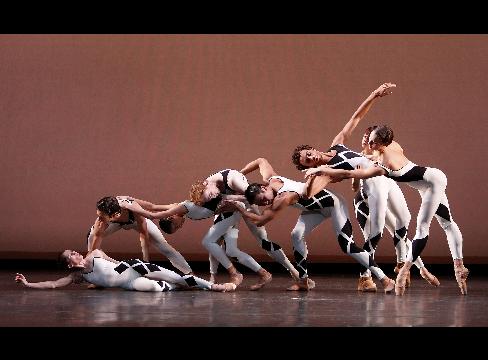
Morphoses/The Wheeldon Company dancers take part in a performance of Christopher Wheeldon's "Commedia" at the New York City Center in New York, Oct. 1, 2008. Photographer: Erin Baiano/Morphoses/The Wheeldon Company via Bloomberg News
Oct. 3 (Bloomberg) -- Morphoses/The Wheeldon Company is still a dance troupe in the making. At the New York City Center through Sunday, it features a cluster of international stars moonlighting to support Christopher Wheeldon's branching out on his own after seven years as resident choreographer of the New York City Ballet. Since forming his group, he has also benefited greatly from the institutional support of City Center and of London's Sadler's Wells Theatre.
The first of two programs contradicted Wheeldon's brashly expressed desire of ``making it new'' -- saying goodbye to Balanchine and all that. In his pre-curtain speech at opening night on Wednesday, he talked about looking to the past for the way to the future; his own recent ``Commedia,'' set to Stravinsky's familiar ``Pulcinella Suite,'' underscored this. Referring to the glory days of Diaghilev's Ballets Russes (which included Massine's ``Pulcinella'' in its repertory), it translates commedia dell'arte-style cavortings and romances into Wheeldon's own cool style, deliberately calling attention to its inventiveness. Its best feature is a love duet typical of this choreographer in its all too self-conscious charm.
The other new work on the bill was Morphoses's first independent commission, which one can only hope is not prophetic. Canadian Emily Molnar's ``Six Fold Illuminate,'' set to Steve Reich's ``Variations for Winds, Strings, and Keyboards,'' suggests that if ever a composer and choreographer were ill-matched, it is this pair.
Hypnotic Spooling
Instead of responding in kind to the music's hypnotic spooling out of delicately varied repetitions, Molnar has two women and four men endlessly showing us flesh being hauled around -- by its owner or partner -- as if it were heavy meat. In the two main duets, the battle of the sexes is rehashed with ever-deadening hostility and co-dependency.
Neither of these creations competes with -- or even complements -- Wheeldon's 2001 ``Polyphonia,'' which introduced the current program and was sveltely performed. Along with the 2002 ``Morphoses,'' these works -- both to Ligeti scores -- made the young choreographer's name. He hasn't topped them yet. Meanwhile, Frederick Ashton's sublime ``Monotones II'' got a sub-par rendition, while the ravishing central duet from that master's ``The Dream'' has been relegated to the second program.
Wheeldon's fame rests on the fact that no one in his generation could rival his suave practical skills in making a contemporary classical ballet. Given the fact that he absorbed and processed so intelligently lessons from the work of Ashton and Kenneth MacMillan in his early dance life with England's Royal Ballet, and George Balanchine and Jerome Robbins when he joined the New York City Ballet, admirers were willing to overlook a certain sameness in his style and its seeming lack of heart.
Now he has a rival in the Bolshoi Ballet's artistic director Alexei Ratmansky, who went through a decade of peripatetic alliances, learning about Western dance without sacrificing his Russian roots. His works (including ``Russian Seasons'' and ``Concerto DSCH,'' made for City Ballet) have been much appreciated in the U.S. for the very humanity that's missing in Wheeldon's.
After an awkward flirtation with City Ballet, Ratmansky recently accepted a five-year appointment as artist in residence with American Ballet Theatre. Perhaps the competition will benefit both choreographers. It will certainly be engaging for audiences.
Through Oct. 5 at 131 W. 55th St., Manhattan. Information: +1-212-581-1212; http://www.nycitycenter.org.
© 2008 Bloomberg L.P. All rights reserved. Reprinted with permission.
This article originally appeared in the Culture section of Bloomberg News on October 2, 2008.
Oct. 2 (Bloomberg) -- Bill T. Jones, most often given to raving and ranting about the world's downside, does a welcome, if ironic, about-face with ``A Quarreling Pair,'' featuring the gaiety, verve, and sometime vulgarity of vaudeville.
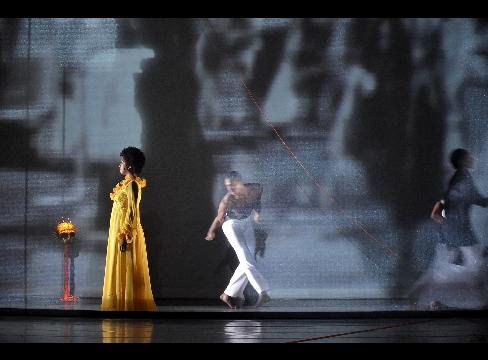
Tracy Ann Johnson plays two sisters, adventurous Rhoda, seen here, and timid Harriet, during a performance of Bill T. Jones's "A Quarreling Pair" at the Brooklyn Academy of Music's Next Wave Festival in New York, on Sept. 29, 2008. Photographer: Stephanie Berger/BAM via Bloomberg News
At the Brooklyn Academy of Music, where it inaugurates this year's Next Wave Festival, the show takes off from Jane Bowles's brief puppet play of the same title, written in the mid-1940s. Aging spinster sisters of conflicting temperaments, Bowles's Miss Harriet and Miss Rhoda are nevertheless inextricably bound, living together in emotional claustrophobia. Harriet is too timid to venture beyond querulous banal exchanges with Rhoda, who yearns to escape -- to live in a wider world and contribute to it -- but never can.
Typically, Jones provides an up-to-date, postmodern take on the circumstances. He begins, pointedly, by having one actress -- the magnetic Tracy Ann Johnson -- play both sisters. He lets Rhoda out of her prison but denies her a happy ending. Harboring a romantic instinct for wanting to help people and also fancying herself a jazz singer, Rhoda fails at both.
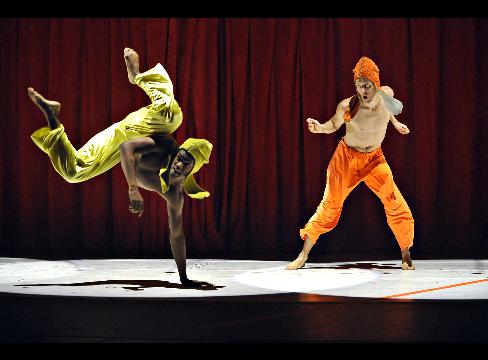
Dancers Antonio Brown, left, and Paul Matteson take part in a performance of Bill T. Jones's "A Quarreling Pair" at the Brooklyn Academy of Music's Next Wave Festival in New York on Sept. 29, 2008. Photographer: Stephanie Berger/BAM via Bloomberg News
She ruins her cabaret act by leaving her mobile phone on -- talking to the sister she left behind. She then manages to hook up with a sleazy Mexican vaudeville show, where an abusive drag queen co-opts her as a dresser and victim. Reduced to wandering the gray streets, she's rejected even by the suffering multitudes.
No Retreat, No Surrender
Nevertheless, Rhoda refuses to retreat to the bland, frustrating safety of home and sister. If degrading and discouraging adventures represent the real world, so be it.
As in much of Jones's work, the plotline is occasionally fuzzy, but the dancers of the Bill T. Jones/Arnie Zane Company, celebrating its 25th anniversary, are terrific -- swift, precise, balletic, jazzy and acrobatic at once. Jones's choreography for them is particularly memorable in the ``exotic'' showbiz acts, where the performers' shenanigans are etched in acid. It's less effective in the passages for the tired, poor and instinctively hostile masses. Jones's affection for characters intent on pushing life to extremes appears to be far stronger than his empathy with figures worthy of pity.
A theatrical multimedia man, Jones, is ably abetted throughout by Bjorn Amelan (set design), Liz Prince (costumes), Robert Wierzel (lighting), Janet Wong (video design) and a trio of musicians: Wynne Bennett, Christopher William Antonio Lancaster, and George Lewis Jr.
No Jones production lacks its thorny issues, which usually come in multiples. In ``A Quarreling Pair,'' Jones hints at the question of what makes any couple or group able to co-exist. He also wonders, if only in a whisper, if it's possible to improve the world and, if not, whether grace lies in trying anyway.
Best of all, though, he's asking loud and clear if performers -- often folks who like to sing, dance and cavort -- shouldn't occasionally be allowed to shed art's deeper and darker concerns and just let the good times roll. The answer to that last one is a heartfelt yes.
Through Oct. 4 at BAM's Howard Gilman Opera House, 30 Lafayette Ave., Brooklyn. Information: +1-718-636-4100; http://www.bam.org.
© 2008 Bloomberg L.P. All rights reserved. Reprinted with permission.
Sitelines
AJ Ads
 360° Dance Company at DTW offers two socially relevant revivals, Jane Dudley’s solo “Time Is Money” (1932) and Mary Anthony’s “Devil in Massachusetts” (1952) as well as the World Premier of Artistic Director, Martin Lofsnes' "6-1".
360° Dance Company at DTW offers two socially relevant revivals, Jane Dudley’s solo “Time Is Money” (1932) and Mary Anthony’s “Devil in Massachusetts” (1952) as well as the World Premier of Artistic Director, Martin Lofsnes' "6-1".
AJ Blogs
AJBlogCentral | rssculture
Terry Teachout on the arts in New York City
Andrew Taylor on the business of arts & culture
rock culture approximately
Laura Collins-Hughes on arts, culture and coverage
Richard Kessler on arts education
Douglas McLennan's blog
Dalouge Smith advocates for the Arts
Art from the American Outback
Chloe Veltman on how culture will save the world
For immediate release: the arts are marketable
No genre is the new genre
David Jays on theatre and dance
Paul Levy measures the Angles
Judith H. Dobrzynski on Culture
John Rockwell on the arts
innovations and impediments in not-for-profit arts
Jan Herman - arts, media & culture with 'tude
dance
Apollinaire Scherr talks about dance
Tobi Tobias on dance et al...
jazz
Howard Mandel's freelance Urban Improvisation
Focus on New Orleans. Jazz and Other Sounds
Doug Ramsey on Jazz and other matters...
media
Jeff Weinstein's Cultural Mixology
Martha Bayles on Film...
classical music
Fresh ideas on building arts communities
Greg Sandow performs a book-in-progress
Harvey Sachs on music, and various digressions
Bruce Brubaker on all things Piano
Kyle Gann on music after the fact
Greg Sandow on the future of Classical Music
Norman Lebrecht on Shifting Sound Worlds
Joe Horowitz on music
publishing
Jerome Weeks on Books
Scott McLemee on books, ideas & trash-culture ephemera
theatre
Wendy Rosenfield: covering drama, onstage and off
visual
Public Art, Public Space
Regina Hackett takes her Art To Go
John Perreault's art diary
Lee Rosenbaum's Cultural Commentary
